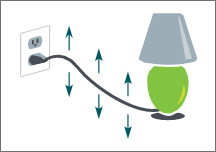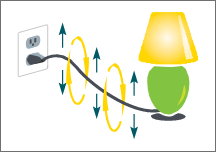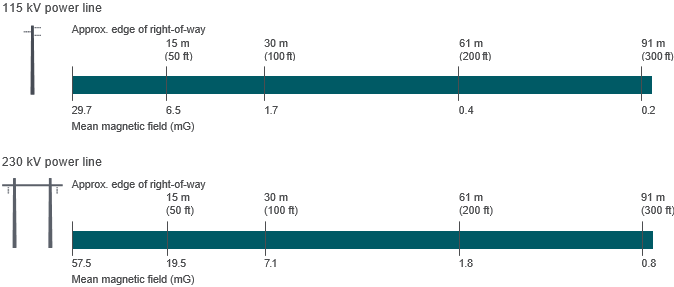Electromagnetic fields
All of us depend on electricity to meet basic needs such as heating, cooling and lighting our homes. We also depend on electricity to meet the transportation, communication, commercial, recreational, industrial and health care requirements of our society. Wherever we make use of electricity, power frequency electric and/or magnetic fields (EMF) are present.
Electric Fields

Electric fields are created around appliances and wires wherever a voltage exists. You can think of electric voltage as the pressure of water in a garden hose – the more voltage, the higher the electric field strength. Electric fields are present when an electrical appliance is plugged in even when turned off. Electric fields diminish rapidly with distance from the source and can be shielded by objects such as trees or the walls of a building.
Magnetic Fields

Magnetic fields are created whenever there is a flow of electric current. This can be thought of as the flow of water in a garden hose. As the amount of current flowing increases, so does the magnetic field. Magnetic fields are present when there is a flow of electricity, such as when an electrical appliance is operating. Magnetic fields are measured in milligauss (mG), and diminish rapidly with distance from the source, but are not shielded by objects such as trees or buildings. The level of magnetic fields from electrical appliances in homes can be as high as or higher than the magnetic fields people may experience under power lines. Magnetic field strength from power lines depend on many factors, including the design of the line, the amount of current the line carries, and the distance from the line.
Median EMF readings in milligauss (mG)
1 NIEHS, EMF Questions and Answers, June 2002
Magnetic fields decrease as distance from electricity sources increases

*levels shown above are examples only, not predictions of actual EMF from PSE lines
Source: National Institute of Environmental Health Sciences (NIEHS), EMF Questions and Answers. June 2002.
Research on EMF
For over 40 years, there have been many scientific studies conducted on power frequency EMF. Extensive reviews and research conducted by leading public health agencies – such as the World Health Organization (WHO) and the U.S. National Cancer Institute (NCI) (one of the U.S. National Institutes of Health) – have not established that power frequency EMF cause any adverse effects in humans or animals.
Based on a recent in-depth review of the scientific literature, the WHO concluded that "current evidence does not confirm the existence of any health consequences from exposure to low level electromagnetic fields."2
2WHO EMF Program website: www.who.int/news-room/q-a-detail/radiation-electromagnetic-fields
Similarly, the US National Cancer Institute has concluded that, “Numerous epidemiologic studies and comprehensive reviews of the scientific literature have evaluated possible associations between exposure to non-ionizing EMFs and risk of cancer in children. … No consistent evidence for an association between any source of non-ionizing EMF and cancer has been found.”
NCI Fact Sheet "Electromagnetic Fields and Cancer" - www.cancer.gov/about-cancer/causes-prevention/ risk/radiation/electromagnetic-fields-fact-sheet
Exposure Limit
Neither the U.S. government nor the state of Washington has established exposure standards for public exposure to power frequency EMF. Two international organizations, the International Commission on Non-Ionizing Radiation Protection (ICNIRP) and the Institute of Electrical and Electronic Engineers International Committee on Electromagnetic Safety (ICES), have developed exposure guidelines that have been endorsed by the WHO.
Established EMF exposure limits
Exceedance of these safety standards requires that a person be exposed to EMF levels higher than those listed above for any duration of time. There are no time restrictions for exposures below the threshold.

PSE's approach
At PSE, safety is always our top priority. We rely on the findings of reputable, international and national scientific and public health organizations and agencies that have reviewed the research on EMF. We understand that you may have concerns about EMF and work to address those concerns by:
- Following all applicable federal, state, county and city rules, regulations and standards when constructing power facilities for the safe and reliable delivery of electric service;
- Remaining informed about important developments in EMF research;
- Sharing accurate and objective information about EMF with our customers.
If you are interested in more information about EMF, you may want to try some of the following sources:
For questions about EMF, contact Customer Service at 1-888-225-5773 to be directed to the right person.
